One guide just for me, and I had to listen most of the day. And she, native Tibetian, juggled with all the Buddha, Lama, and Bodhisattva names and was really hoping after seen one of them twice I would recognize him the third time by name…oh, I was glad already if I could make out the 3 Buddhas of the past, the present, and the future, and that only because they reminded by of Charles Dicken’s famous “A Christmas Carol”, but dared not mentioning this far-fetched comparison… In addition, in Buddhism live is reborn in reincarnations. So it might happen that you come across the same ‘spirit’ in different forms. The Dalai Lamas, for example, are continuous reincarnations.
Drepung Monastery
As so many monasteries (is there any one, which is not?) this is built in the slopes of the surrounding mountains, steep, but by no means inaccessible. If I remember correctly, then this was the seat of the 2. through 5. Dalai Lama. The 5. Dalai Lama then built Potala Palace, which since then is the Dalai Lamas’ home, also for the current 14. Dalai Lama, who however, as we all know, lives in Indian exile.
Taking pictures within the buildings is either prohibited right away or subject to an additional comparibly high fee, which I have today not paid. Tomorrow, in Potala Palace, I would pay whatever is necessary.
But it is difficult anyway, to squeeze the atmosphere into a few million pixels. All monasteries are still in use and worshippers and monks keep coming and going, lining up in endless queues to walk past the various Buddhas, Lamas, and other statues, donate money or yak butter (for the ever burning candles) or follow other traditions for being blessed. And intermixed with these masses the tourists, which then actually look comparably few, walk past the same ways and are mostly simply left alone, sometimes friendly smiled at. At the beginning a bit weird as I felt like disturbing religious activities (you would never walk around in a church during a service!) I soon got used to it and actually even enjoyed it as it was obviously quite normal.
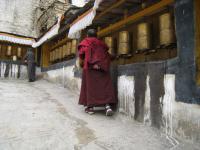
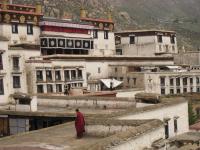
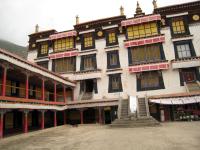
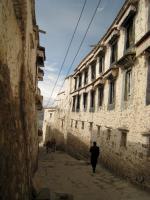
LS_20070623_092411.jpg: These famous turnable cylinders are supposed to contain scripts and turning them means “reading” them…you would need to be very quick, though! 😉 Unlike many pictures I had seen before they all have some kind of handles to turn them, so you don’t touch the actual cylinder.
LS_20070623_092824.jpg: A part of the monstery, mostly living quaters for the still several hundred monks living there.
LS_20070623_094343.jpg: One of the many buildings containing various chapels, which in turn contain endless Buddha and other statues.
LS_20070623_104857.jpg: A narrow way on the way out.
NorbuLingKa Palace & Park
This is the Dalai Lamas’ summer residence. The park is with 360,000 square meters quite large. One has to admit, though, that the Tibetians are not the masters of gardening art. The more interesting sites are the 2 actual palaces, which, compared to the winter residences (Drepung Monastery or Potala Palace) are very small, though. In them taking pictures was forbidden altogether, which leaves me with only few possibilities…
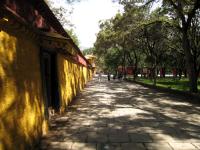
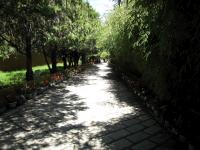
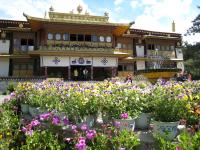
LS_20070623_112419.jpg: A way along the wall surrounding the smaller of the palaces. The park mainly consists of trees.
LS_20070623_112813.jpg: Walking way to the second, newer and larger palace…
LS_20070623_113012.jpg: …which is this one. It has been built for the 14. Dalai Lama only in the 50’s. He could enjoy it only a few years before forced into exile. The palace contains various very comfortably furnished rooms, especially laid out with beautiful carpets and wall paintings, for sleeping, meeting, studying. Even some rooms for the Dalai Lamas mothers. Yes, I have repeatedly heard an “-s” at the end of mother. Not sure if Lamas have multiple mothers…but my guide said mothers. And the mothers even have a modern bathroom with a sitting toilet. While the Dalai Lama himself has wonderful living and meeting rooms, but I don’t know where he goes in the morning…
We had a simple but tasty lunch afterwards in a local tibetian restaurant in the city. Not, as so often on other Chinese tours, in a tourist trap, but really local-local, as my Shanghai colleagues put it, when it got really off the beaten tracks. Well…the place is at one of the main streets, large, and soon filled up with locals, and as the menu had pictures I could even help deciding on the dishes. Both guide and even the driver sat down with me, so I was luckily not left alone, though I had to eat most of the stuff.
Next scheduled item was a lunch break. They wanted to bring me back to my hotel. As I had figured that it was just one block down through some souvenir streets I said I don’t need to be taken down by car, I would walk. (The hotel’s entry is quite small and in a pedestrian street, so it’s always a bit of an effort to get a car in and out.) That was accepted, and when we left the restaurant the driver walked away. The guide, however, wanted to walk me the five minutes to my hotel! I needed to argue hard to convince her that I would know exactly where I am and that I would find the hotel just by myself and, no, I would not need directions. When she finally accepted she ran after the driver to get on the car at least herself…
Sera Monastery
The last visit of the day. I actually don’t have any good pictures from its outside. And inside I didn’t take pictures again for the known reasons. Also, it was very crowded. There was some kind of blessing for children going on, which I had not understood. But as a matter of fact many mothers lined up with the young kids, often babys carried on their arms. We only slowly could pass by the crowd, which did take all the lining up and winding through the various rooms good-humored and let us pass with smiles. At the actual spot the grown ups had to briefly kneel down and put their head into some dark chamber below a Buddha statue; no idea what they would find there. And the kids got a black mark on their nose as evil-prevention. Also later in the city I saw many kids on the streets with that black nose tip.
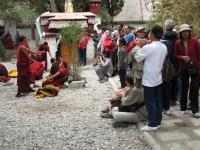
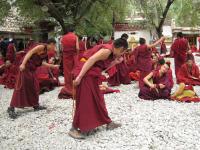
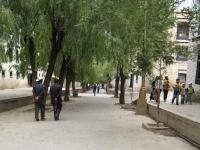
LS_20070623_154210.jpg: The really interesting thing happened outside anyway: A discussion rounds of monks. If I got the explanation right, then they practice arguing there. There are many groups of 2 to 5 monks, one of them standing, facing questions by the others and needing to answer them, while the sitting monks concider the answers. Surrounded was the entire scene, which happens every afternoon except for Sundays, by a large crowd of tourists, shooting their camers at the monks. Looked sometimes a bit like a zoo.
LS_20070623_154436.jpg: But very obviously the monks had fun doing it. See here two standing monks in a more fight-like position. They really took it with passion, clapped their hands loudly while answering, but obviously sometimes also made fun of themselves, but mostly the sitting monks really seem to listen carefully.
LS_20070623_154925.jpg: A street within the Sera Monastery…basically the only outside picture I have.
Walking Around
That was today’s program, done by 16:00. The daylight reaches considerably longer into the evening here in Tibet, which would be 2-3 timezones west of BeiJing, if BeiJing would care. So effectively Tibet is always running “Daylight Saving Time”. Even now, 20:30, there’s still light outside, while in Shanghai, several thousand kilometers east, the sun is gone latest by 18:30.
OK…there would be sun only if there wouldn’t be rain clouds. It had brightened up over the day, but now clouds closed in again and spit some rain.
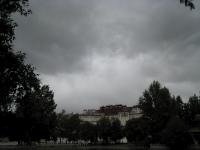
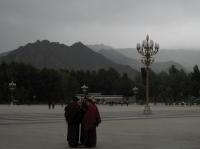
LS_20070623_163208.jpg: I eventually wanted to see the Potala Palace a bit more closely. To be honest, it had not impressed me when driving past in the van. This is probably due to the fact that the palace is, as so many buildings, built along the slop of a hill, but not into the slope of a large mountain. Thus, it effectively sits on top of a hill, and you see that small hill very clearly when approaching it by car from the side, which somehow reduces the impression.
But standing in front of the palace and looking at its magnificience is a completely different story! Given the bad weather there’s no great picture of it yet. But this one here looks good in its large version (click on it) as the dark clouds seem to surround the palace, here looking very small and vulnerable, which it certainly in reality not is.
LS_20070623_164259.jpg: Across the palace their nowadays is a Tian’AnMen-like square, put there by the Chinese government, with some ugly military column at its back and a Chinese flag at the front, which is hard but possible to avoid to have on palace pictures. This picture here is a view diagonally across the square, also avoiding all its Chinese features, with a group of monks in front and the ubiquious mountain view in the back.
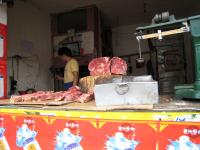
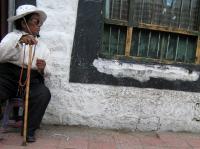
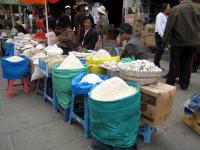
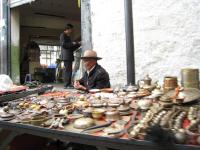
LS_20070623_170846.jpg: Until dinner time I walked through the streets and took some more hip shots. Here a butcher. Can’t what kind of meat that is, which “dries” here at the fresh air, but the chances that it is yak meat are quite high.
LS_20070623_171453.jpg: Isn’t that guy cool? Unfortunately I cut off his right leg on the pic, but his features are still great.
LS_20070623_171817.jpg: Market in the streets with lots of grains…
LS_20070623_172031.jpg: …and lots of small brass things.
Today’s Lesson: Buddhism has many names to remember…and their ongoing reincarnations don’t make things simpler either.
Categories: Asia, Lhasa
Originally Created: 06/23/2007 01:43:50 PM
Last Edited: 06/23/2007
One thought on “Lhasa (II) Crash Course Buddhism”
Comments are closed.